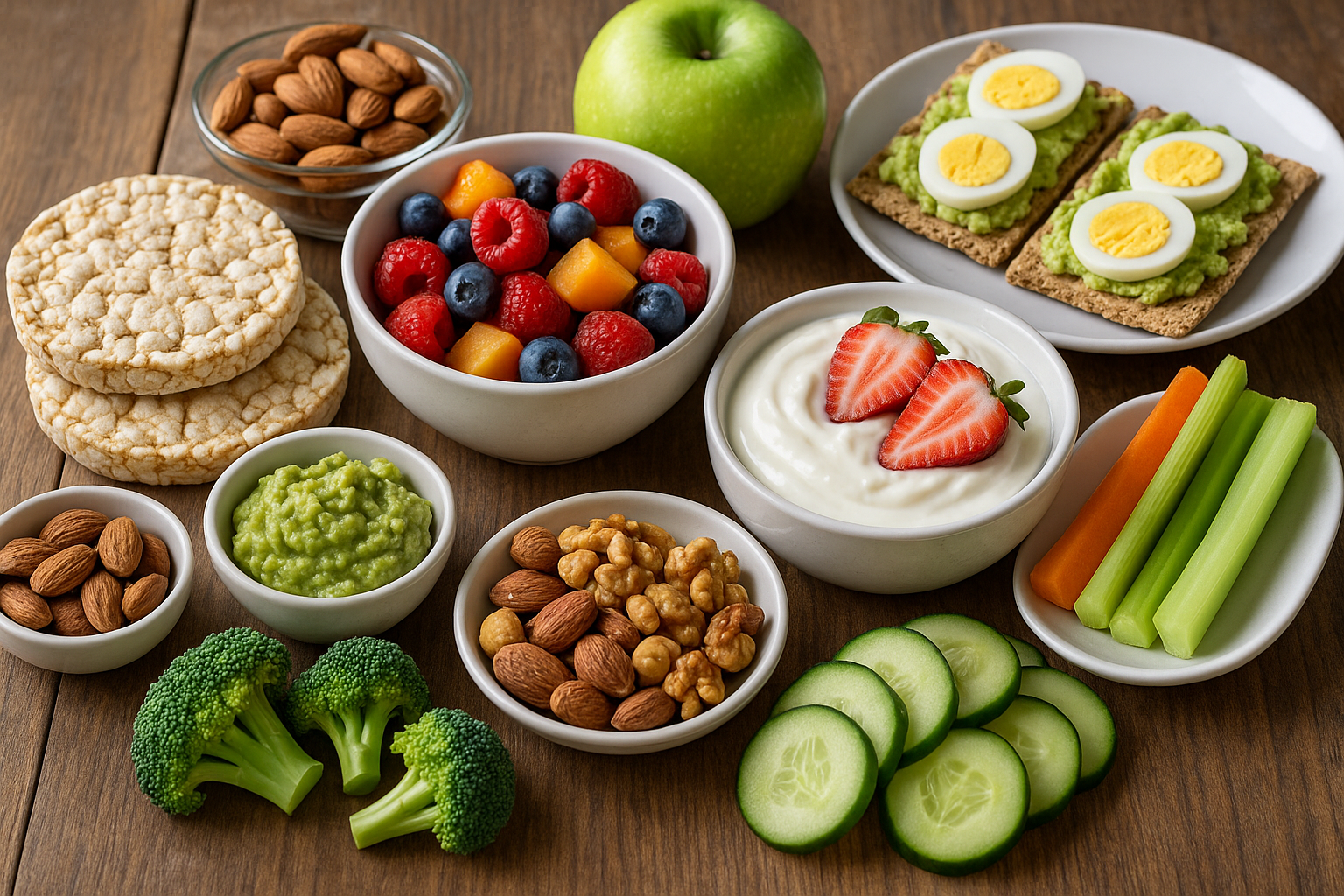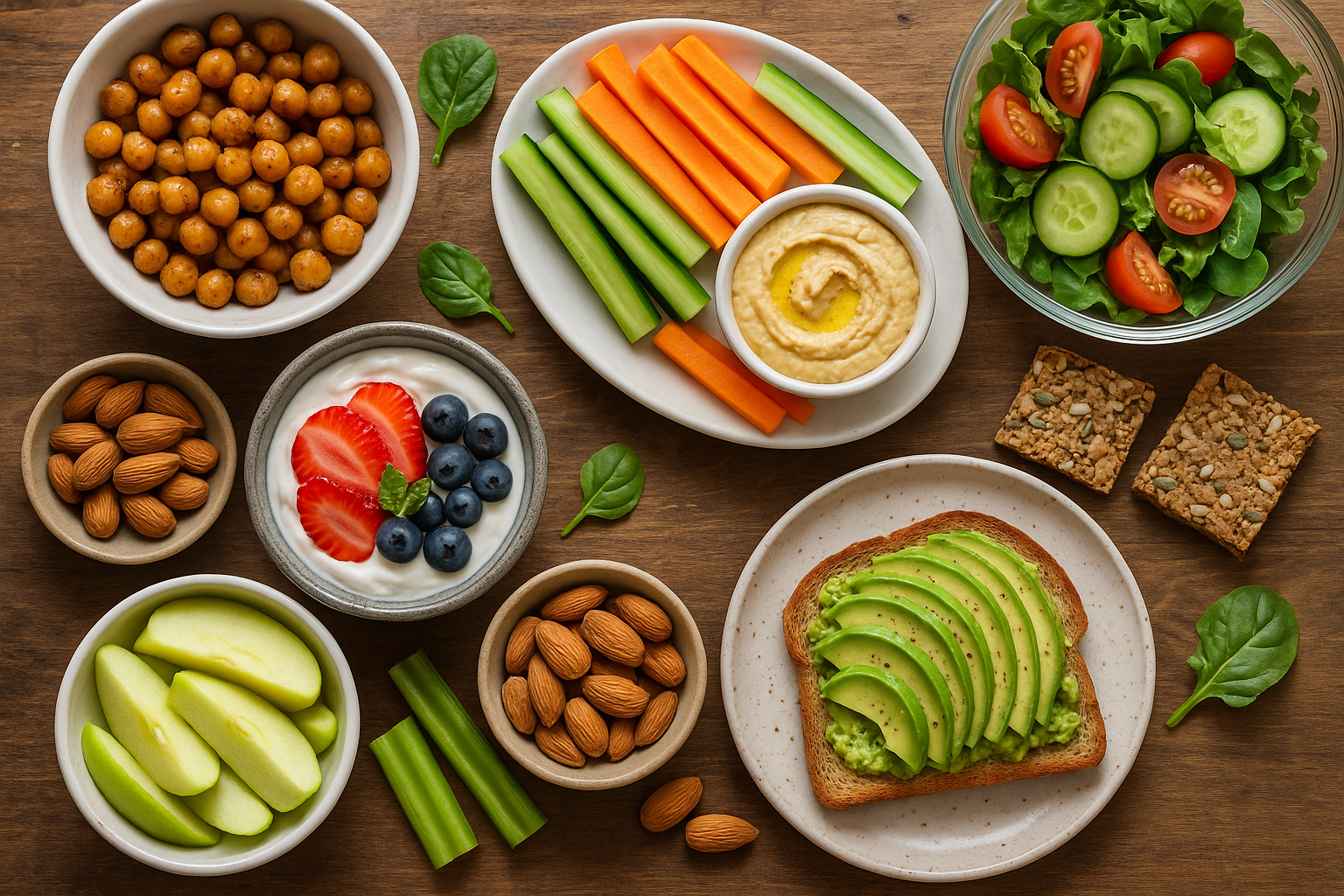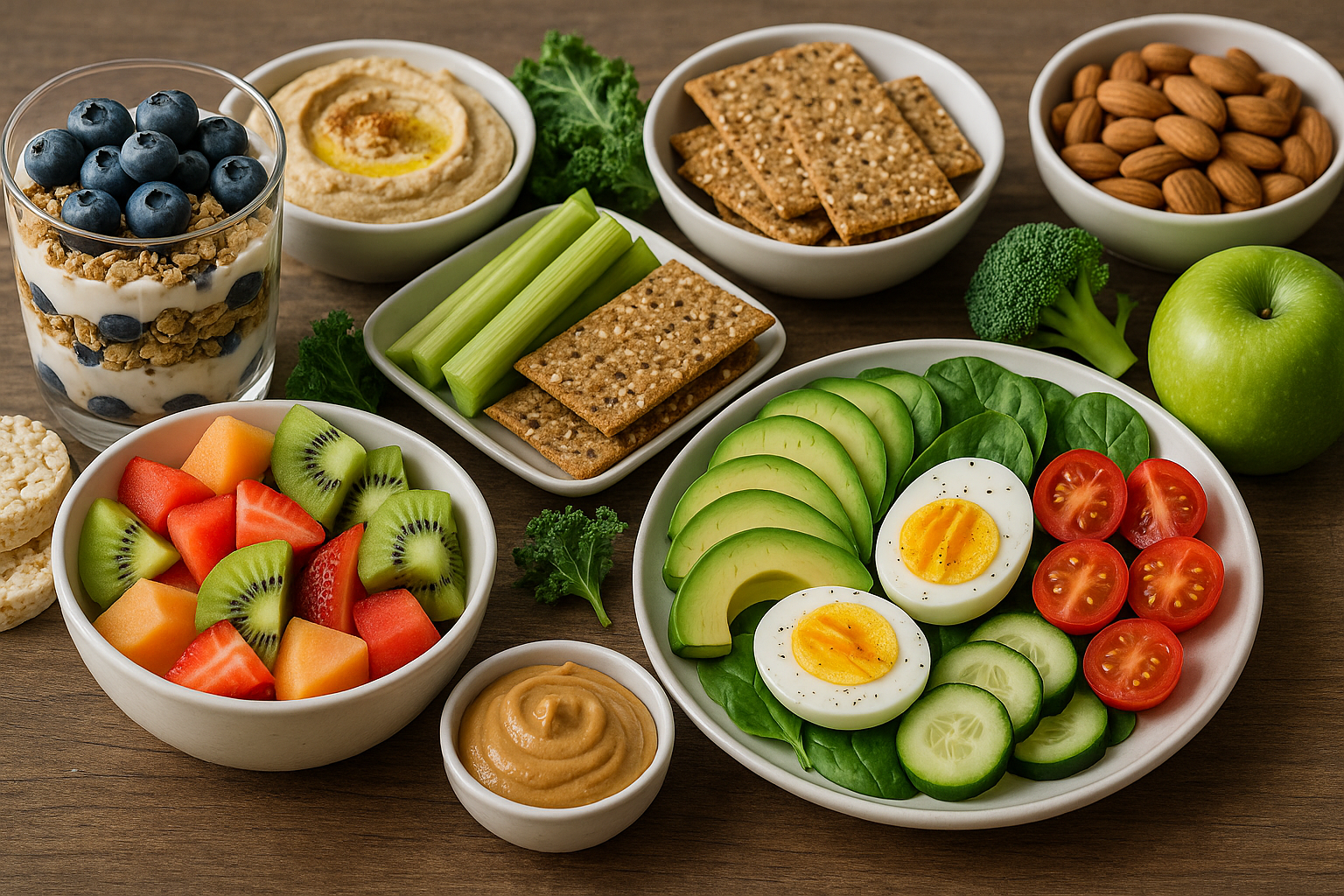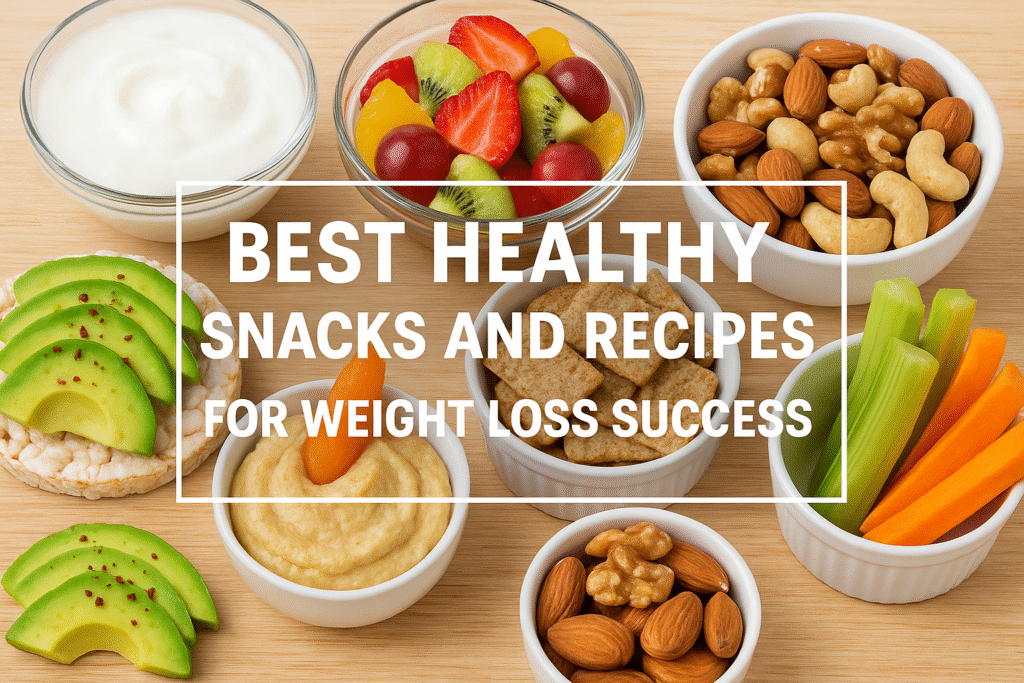Smart snacking can be a powerful tool for weight-loss success when you choose nutrient-dense options, watch portion sizes, and pair carbs with protein or fiber to stay satisfied longer. Below are practical principles, a list of top snack choices, and easy recipes you can make at home — along with tips for prepping, storing, and customizing them to fit dietary preferences.
Why these snacks help
– Protein and fiber increase satiety and reduce overall calorie intake by curbing hunger between meals.
– Whole, minimally processed foods deliver nutrients without added sugars and empty calories.
– Combining a carbohydrate with a protein or healthy fat (for example, apple + nut butter) stabilizes blood sugar and cravings.
– Volume foods (vegetables, broth-based soups) let you eat satisfying portions for fewer calories.
Top healthy snacks to keep on hand
– Plain Greek yogurt (or dairy-free alternative) with fresh berries and a sprinkle of chia or hemp seeds
– Fresh fruit with 1–2 tbsp nut or seed butter
– Raw or roasted vegetables (carrot sticks, cucumber, bell pepper) with hummus or tzatziki
– Hard-boiled eggs or egg muffins (portable, high-protein)
– Air-popped popcorn seasoned lightly (limit butter/oil)
– Cottage cheese with pineapple or sliced cherry tomatoes and pepper
– Edamame (steamed, lightly salted) — high in protein and fiber
– Roasted chickpeas or lupini beans (crispy, savory plant protein)
– Whole-grain crispbreads or rice cakes topped with avocado and smoked salmon or turkey slices
– Handful of nuts or seeds (about 1 oz / 28 g) paired with a piece of fruit
Simple recipes that support weight-loss goals
Notes: Adjust seasonings, reduce added fats/sugars, and watch portion sizes to keep snacks aligned with your calorie targets.
1) Greek Yogurt Berry Parfait
Serves: 1
Ingredients:
– 3/4–1 cup plain Greek yogurt (or unsweetened plant yogurt)
– 1/2 cup mixed berries (fresh or thawed frozen)
– 1 tbsp chia seeds or ground flaxseed
– Optional: 1 tsp honey or a few drops of vanilla
Directions:
1. Layer yogurt, berries, and seeds in a bowl or jar.
2. Drizzle honey if desired. Mix and enjoy.
Why it helps: High in protein and fiber; keeps you full and helps preserve lean mass while dieting.
Estimated calories: 150–250 depending on yogurt type and portion.
2) Veggie Sticks + Creamy Hummus (make-ahead)
Makes: ~6 servings of hummus
Ingredients:

– 1 can (15 oz) chickpeas, drained and rinsed
– 2 tbsp tahini
– 1–2 tbsp lemon juice
– 1 garlic clove
– 2 tbsp water (more to thin)
– 1 tbsp olive oil (optional)
– Salt and pepper to taste
– Cut veggies: carrots, cucumber, bell pepper, celery
Directions:
1. Blend chickpeas, tahini, lemon, garlic, water, and oil until smooth. Season.
2. Store hummus in fridge (up to 5 days). Portion 2 tbsp hummus with veggies for snack.
Why it helps: Fiber and protein from chickpeas slow digestion and reduce cravings.
Estimated calories per snack: ~120–150 (2 tbsp hummus + veggies).
3) Baked Spiced Chickpea Crunch
Makes: ~4 servings
Ingredients:
– 1 can chickpeas, rinsed and patted dry
– 1 tsp olive oil
– 1/2 tsp smoked paprika, 1/4 tsp cumin, pinch salt
Directions:
1. Preheat oven to 400°F (200°C).
2. Toss chickpeas with oil and spices, spread on baking sheet.
3. Bake 25–35 minutes, shaking once, until crisp. Cool before storing.
Why it helps: Satisfying crunch and plant protein without excess fat — good alternative to chips.
Estimated calories per 1/2-cup serving: 120–150.
4) Egg White Veggie Muffins (high-protein, low-calorie)
Makes: 6 muffins
Ingredients:
– 6 egg whites (or 3 whole eggs + 3 egg whites)
– 1/2 cup finely chopped spinach
– 1/4 cup diced bell pepper
– 2 tbsp diced onion
– Salt, pepper, and herbs to taste

Directions:
1. Preheat oven to 350°F (175°C). Spray or line a muffin tin.
2. Whisk egg whites, stir in veggies and seasonings. Pour into tin and bake 18–22 minutes.
3. Refrigerate and reheat for quick snacks.
Why it helps: Portable, lean protein that preserves fullness between meals.
Estimated calories per muffin: 40–70 (depending on whole vs. whites).
5) Apple + Almond Butter Oat Bites (no-bake)
Makes: ~12 bites
Ingredients:
– 1 cup rolled oats
– 1/2 cup unsweetened applesauce
– 1/4 cup almond butter
– 1 tbsp chia seeds
– 1/4 tsp cinnamon
– Pinch of salt
Directions:
1. Mix all ingredients in a bowl, form into bite-sized balls, refrigerate to firm up.
2. Store in fridge up to 5 days.
Why it helps: Balanced carbs, fiber, and healthy fat for steady energy.
Estimated calories per bite: 70–90 (depending on size).
6) Savory Cottage Cheese Bowl
Serves: 1
Ingredients:
– 1/2 cup low-fat cottage cheese
– 1/2 cup cherry tomatoes, halved
– 1 tbsp chopped fresh herbs (basil, chives)
– Freshly ground pepper
Directions:
1. Combine cottage cheese with tomatoes and herbs. Season and enjoy.
Why it helps: Cottage cheese is rich in casein protein, promoting satiety and muscle retention.
Estimated calories: 90–140.
7) Green Smoothie (fiber-forward)
Serves: 1

Ingredients:
– 1 cup unsweetened almond milk or water
– 1 cup spinach or kale
– 1/2 small frozen banana or 1/2 cup frozen mango
– 1 scoop protein powder or 2 tbsp Greek yogurt
– 1 tbsp chia or flaxseed
Directions:
1. Blend until smooth. Adjust thickness with water.
Why it helps: Portable, hydrating, and high in fiber + protein; good pre- or post-workout snack.
Estimated calories: 160–260 depending on protein source and fruit.
Portion control and timing tips
– Aim for snacks around 150–300 calories depending on overall daily calories and hunger.
– Snack when genuinely hungry or to bridge long gaps between meals; avoid mindless eating out of boredom.
– Pair protein + fiber in most snacks to maximize fullness (example: fruit + cheese, yogurt + nuts, hummus + veggies).
– Use smaller plates, pre-portion into containers or bags, and avoid eating directly from large packages.
Make-ahead and storage strategies
– Batch-cook egg muffins, hummus, roasted chickpeas, and yogurt parfait components for grab-and-go options.
– Store single-serving portions in clear containers so you see and reach for them.
– Freeze portions of energy bites and defrost overnight for a longer shelf life.
Substitutions and dietary adaptations
– Vegan: use unsweetened plant yogurts, tofu or tempeh for protein, and seed butters.
– Gluten-free: use certified gluten-free oats, rice cakes, or naturally gluten-free snacks.
– Lower-carb: emphasize vegetables, eggs, cheese, and nuts; limit fruit and grains.
– Food allergies: swap nuts for seeds (sunflower, pumpkin) and choose allergy-safe dairy alternatives.
Shopping list basics
– Greek yogurt or plant yogurt, eggs, canned chickpeas, rolled oats, nut/seed butter, fresh fruits and vegetables, spinach/kale, cottage cheese, nuts and seeds, whole-grain crackers or rice cakes, spices, and lemons.
Quick behavioral tips for long-term success
– Track portions for a few weeks to learn how many calories your snacks contribute to your day.
– Keep tempting, highly processed snacks out of sight or out of the house.
– Drink water first when you feel mildly hungry — sometimes thirst is mistaken for hunger.
– Pair snacks with a short walk or light activity to help control appetite and improve mood.
Final note
Healthy snacks won’t magically cause weight loss, but choosing nutrient-dense, portion-controlled options that combine protein and fiber can reduce overall calorie intake, prevent overeating at meals, and help you maintain energy and focus. Combine smart snacking with balanced meals, regular activity, and consistent sleep for the best chance of sustainable weight-loss success.

